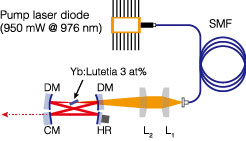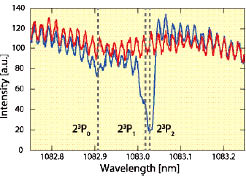Ultra-Broad Mode-Spacing Optical Frequency Comb
Kobayashi Group
A mode-locked oscillator produces bunch of regularly spaced longitudinal modes in an optical frequency region. It is called as an optical frequency comb. When the frequency comb was invented, it was regarded as a dream light source since one oscillator produces tens of thousands modes, corresponding to thousands of ultra-narrow linewidth cw lasers. Many people said that cw lasers were no longer necessary since making the mode-locked laser was easier than making very stable cw lasers. However, this story was not correct. One could not chose one comb tooth from neighboring modes because the mode spacing was too small to pick by using any dispersive optics. The mode-spacing is a repetition rate of the mode-locked (ML) oscillator, the high-repetition rate then makes broad mode spacing. The repetition rate of the ML laser is determined by the cavity length since only one pulse is propagating in a cavity. The smaller cavity then produces the broader mode-spacing optical frequency comb. Another direction is to make higher resolution spectrometer or spectrograph to resolve each mode. The highest frequency resolution in a commercially available spectrometer is about 4 GHz in an optical frequency, then the higher repetition rate than 4 GHz is crucial to resolve comb teeth.

Fig. 1. Schematic of the experimental setup. DMs, dichroic mirrors; CM, chirp-compensation mirror; HR, high reflection mirror; L1 and L2, lenses.

Fig. 2. Absorption spectroscopy of meta-stable He. Red curve shows the laser spectrum without He atoms. The modulation correspond comb structure. Blue curve was obtained with meta-stable He atoms. We can see clear two absorptions that correspond to the triplet S to triplet P transitions in a meta-stable state. 1S-2S transition is strictly prohibited so that the metastable life time is long enough to observe these transitions.
Here we report on our recent progress of high-repetition-rate ML oscillator [1]. We are concentrating on the laser-diode (LD) pumped Kerr-lens ML oscillator. There are some reasons to study this type of lasers. Typical high-repetition-rate comb is made by using Ti:sapphire laser pumped by a large green laser which is not easy to keep running for many days. However, many applications of the frequency comb require long-term operation. A single-mode-fiber (SMF) coupled LD can be kept running as long as we need without any degradation or miss alignment. The main drawback is its poor power. The highest power of the SMF coupled LD is limited below 1 W. Lower power pumping makes it difficult to realize high-repetition-rate ML oscillator. We invented new scheme of the ML oscillator with high finesse. This makes the intra-cavity power high enough to realize the Kerr-lens ML. By adopting Yb-doped ceramic as a gain medium, we have realized 6-GHz repetition rate oscillator with femtosecond pulse duration.
Figure 1 shows the schematic of the small oscillator. ML oscillator consists of two concave mirrors and two plane mirrors. One of the plane mirror is specially coated to compensate a chirp in the cavity. 1-mm-thick Yb:Lu2O3 ceramic was used for the laser gain. Obtained spectrum width was about 8 nm, and the measured pulse duration was 160 fs. By using commercially available optical spectrum analyzer, each comb mode was clearly resolved. This comb is applied for the precision spectroscopy of meta-stable He atoms, which has three absorption lines in the spectrum of this laser. Figure 2 shows the absorption spectroscopy of He obtained with 5.2-GHz repetition rate at this time. Three lines correspond 23S1- 23P0, 23S1- 23P1 and 23S1- 23P2 transitions. The energy spacing of 23P0- 23P1 is 30 GHz, and that of 23P1- 23P2 is 2 GHz, which is too small to resolve in this setup. The absolute frequency could be determined if the offset frequency is controlled, although it is not realized yet.
We have demonstrated the multi-GHz repetition-rate Kerr-lens ML oscillator with LD pumping for the first time to our best knowledge. It would open new applications with mode-resolved spectroscopy. The astronomical application is one of the promising candidate, in which this kind of laser could be used in order to find extra-solar planets.
References
- [1] M. Endo, A. Ozawa, and Y. Kobayashi, Opt. Lett. 38, 4502 (2013).
